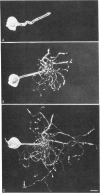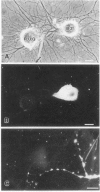Abstract
An important criterion for classifying a substance as a neurotransmitter is that it is released in an activity-dependent fashion. We have utilized cell culture of individual neurons of Aplysia to demonstrate the release of the neuropeptides SCPA and SCPB (small cardioactive peptides A and B). Neurons B1 and B2 were isolated from the buccal ganglion of Aplysia and maintained in cell culture. The cells grew new processes, which were immunoreactive to antibodies for the neuropeptide SCPB. These processes contained SCPA and SCPB that were detectable by bioassay on snail heart. The cells synthesized the SCPs from radiolabeled precursors and transported the peptides to their neurites. Single cells released SCPs in a calcium-dependent fashion upon intracellular electrical stimulation. Taken together, these results provide critical evidence that SCPs are neurotransmitters. The results also indicate that the cell culture of individual identified neurons can be used to investigate the release of peptides.
Full text
PDF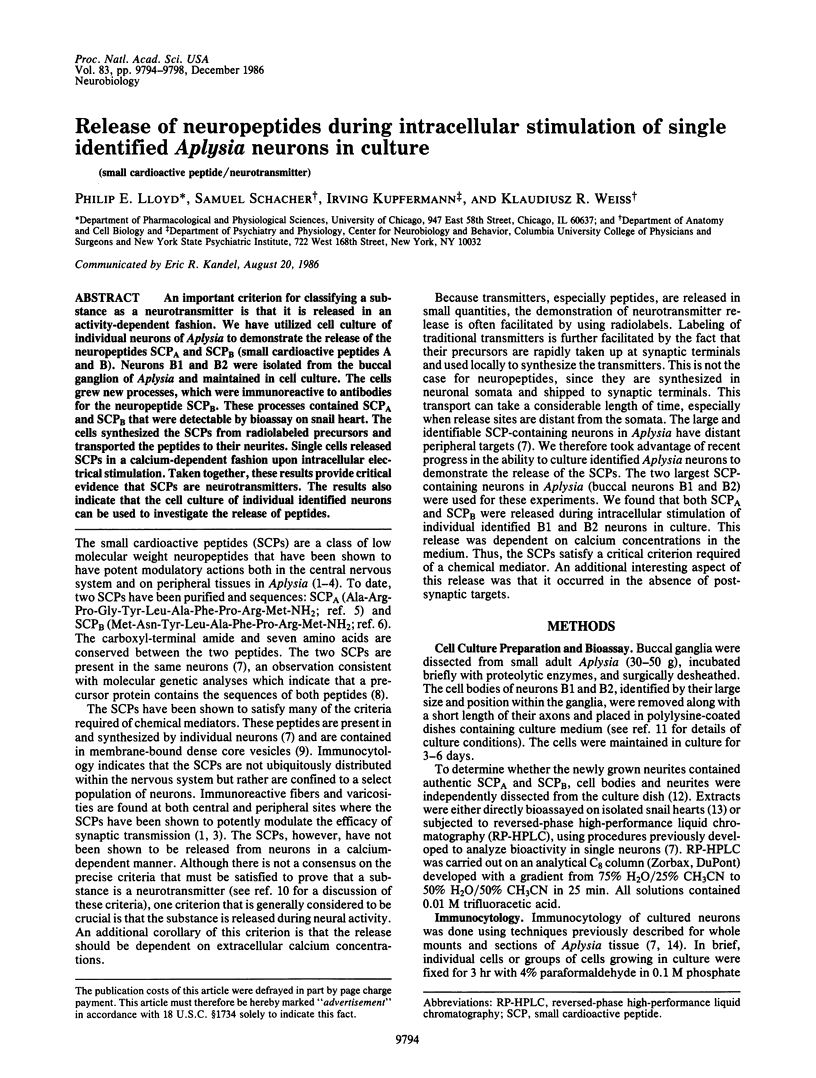
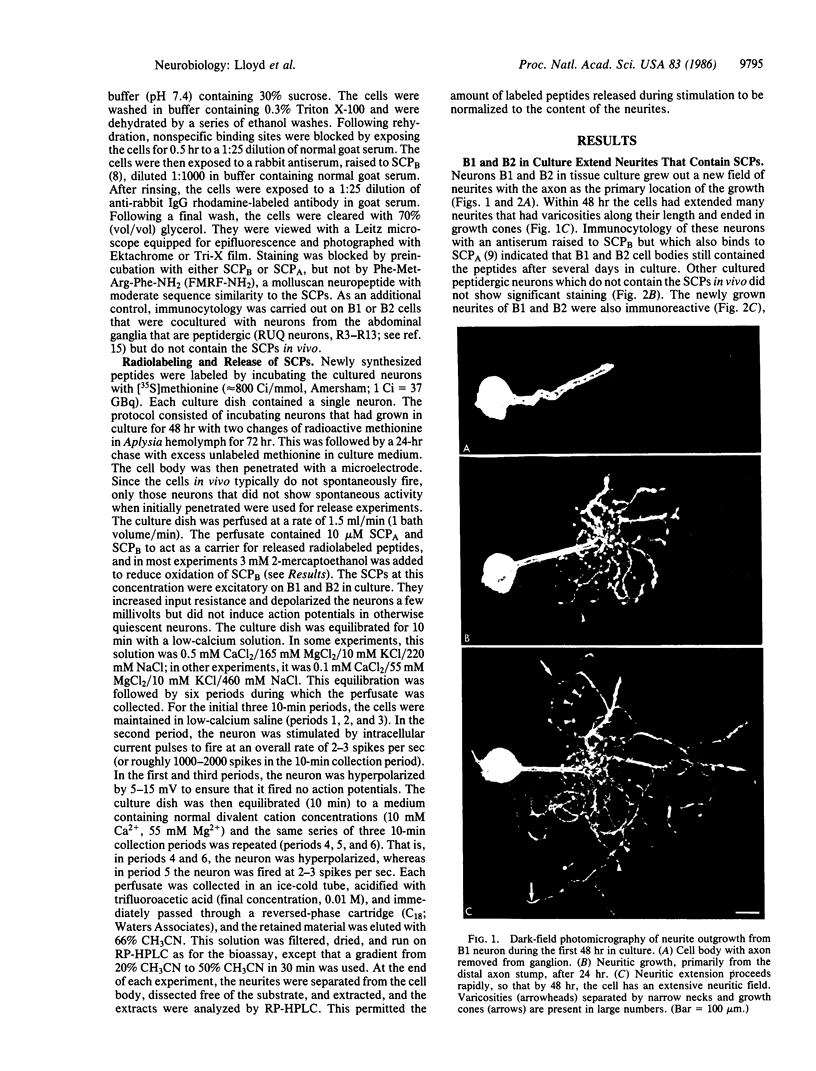
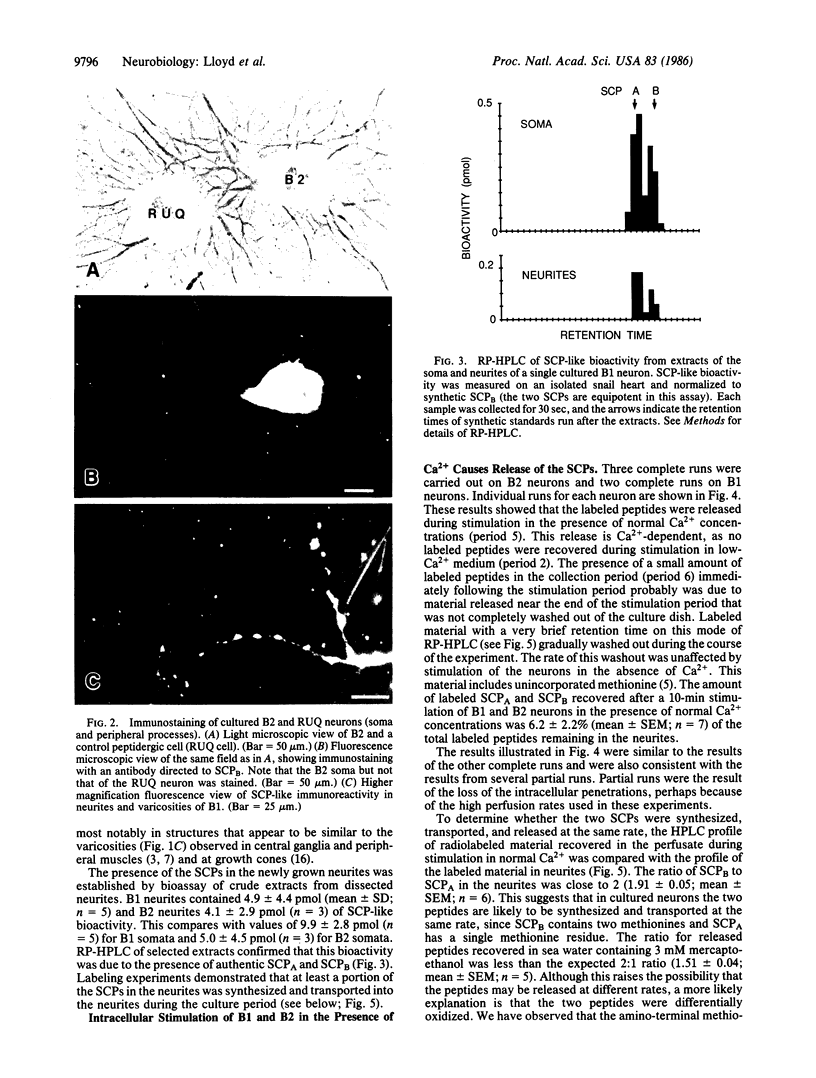
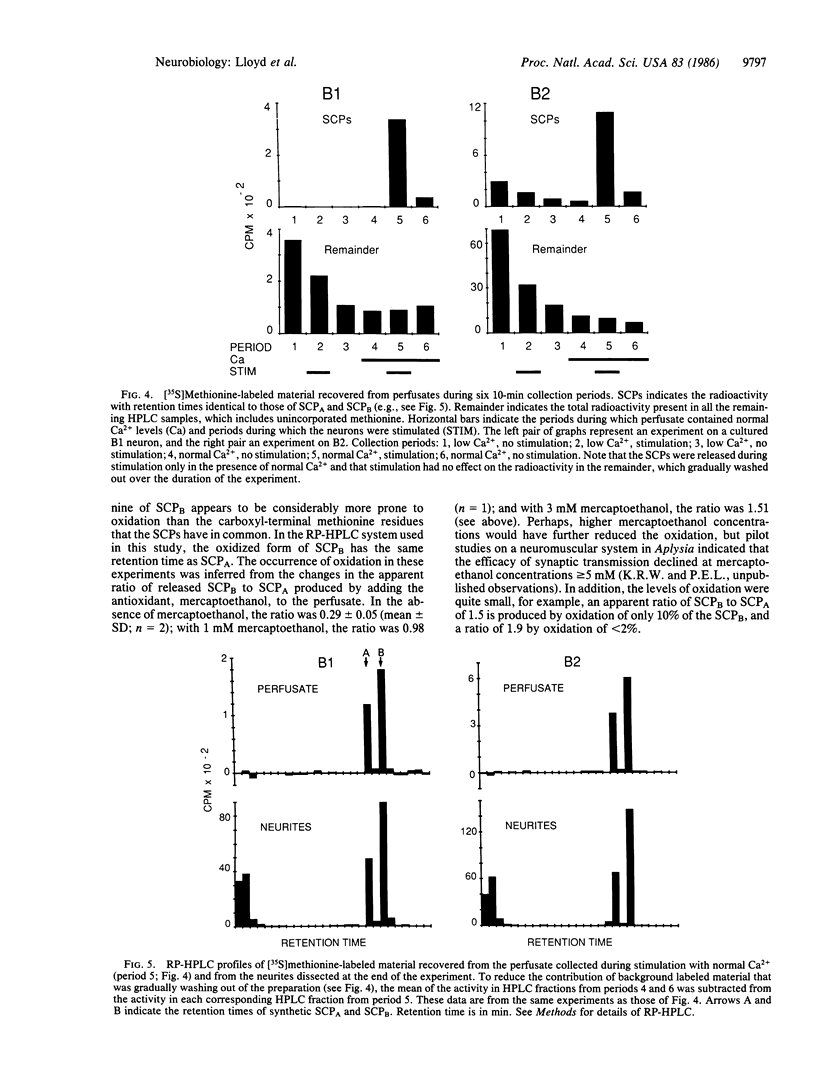
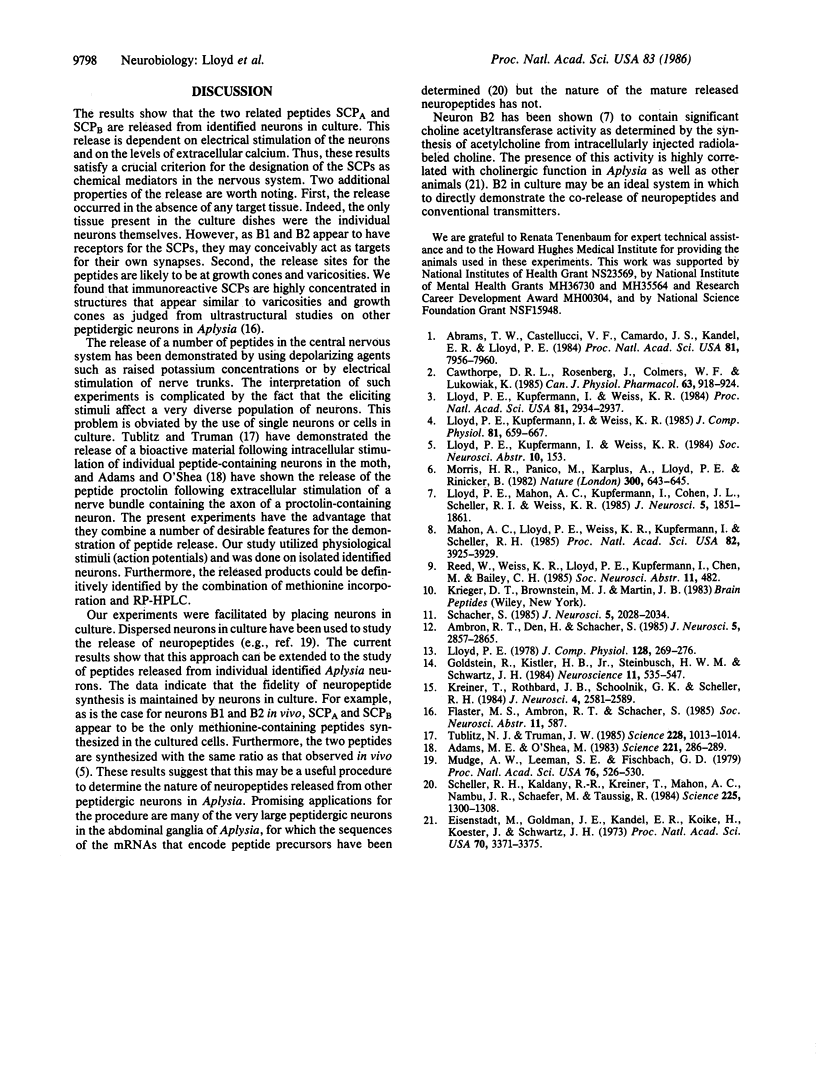
Images in this article
Selected References
These references are in PubMed. This may not be the complete list of references from this article.
- Abrams T. W., Castellucci V. F., Camardo J. S., Kandel E. R., Lloyd P. E. Two endogenous neuropeptides modulate the gill and siphon withdrawal reflex in Aplysia by presynaptic facilitation involving cAMP-dependent closure of a serotonin-sensitive potassium channel. Proc Natl Acad Sci U S A. 1984 Dec;81(24):7956–7960. doi: 10.1073/pnas.81.24.7956. [DOI] [PMC free article] [PubMed] [Google Scholar]
- Adams M. E., O'Shea M. Peptide cotransmitter at a neuromuscular junction. Science. 1983 Jul 15;221(4607):286–289. doi: 10.1126/science.6134339. [DOI] [PubMed] [Google Scholar]
- Ambron R. T., Den H., Schacher S. Synaptogenesis by single identified neurons in vitro: contribution of rapidly transported and newly synthesized proteins. J Neurosci. 1985 Nov;5(11):2857–2865. doi: 10.1523/JNEUROSCI.05-11-02857.1985. [DOI] [PMC free article] [PubMed] [Google Scholar]
- Cawthorpe D. R., Rosenberg J., Colmers W. F., Lukowiak K., Drummond G. I. The effects of small cardioactive peptide B on the isolated heart and gill of Aplysia californica. Can J Physiol Pharmacol. 1985 Aug;63(8):918–924. doi: 10.1139/y85-152. [DOI] [PubMed] [Google Scholar]
- Eisenstadt M., Goldman J. E., Kandel E. R., Koike H., Koester J., Schwartz J. H. Intrasomatic injection of radioactive precursors for studying transmitter synthesis in identified neurons of Aplysia californica. Proc Natl Acad Sci U S A. 1973 Dec;70(12):3371–3375. doi: 10.1073/pnas.70.12.3371. [DOI] [PMC free article] [PubMed] [Google Scholar]
- Goldstein R., Kistler H. B., Jr, Steinbusch H. W., Schwartz J. H. Distribution of serotonin-immunoreactivity in juvenile Aplysia. Neuroscience. 1984 Feb;11(2):535–547. doi: 10.1016/0306-4522(84)90043-5. [DOI] [PubMed] [Google Scholar]
- Kreiner T., Rothbard J. B., Schoolnik G. K., Scheller R. H. Antibodies to synthetic peptides defined by cDNA cloning reveal a network of peptidergic neurons in Aplysia. J Neurosci. 1984 Oct;4(10):2581–2589. doi: 10.1523/JNEUROSCI.04-10-02581.1984. [DOI] [PMC free article] [PubMed] [Google Scholar]
- Lloyd P. E., Kupfermann I., Weiss K. R. Evidence for parallel actions of a molluscan neuropeptide and serotonin in mediating arousal in Aplysia. Proc Natl Acad Sci U S A. 1984 May;81(9):2934–2937. doi: 10.1073/pnas.81.9.2934. [DOI] [PMC free article] [PubMed] [Google Scholar]
- Lloyd P. E., Mahon A. C., Kupfermann I., Cohen J. L., Scheller R. H., Weiss K. R. Biochemical and immunocytological localization of molluscan small cardioactive peptides in the nervous system of Aplysia californica. J Neurosci. 1985 Jul;5(7):1851–1861. doi: 10.1523/JNEUROSCI.05-07-01851.1985. [DOI] [PMC free article] [PubMed] [Google Scholar]
- Mahon A. C., Lloyd P. E., Weiss K. R., Kupfermann I., Scheller R. H. The small cardioactive peptides A and B of Aplysia are derived from a common precursor molecule. Proc Natl Acad Sci U S A. 1985 Jun;82(11):3925–3929. doi: 10.1073/pnas.82.11.3925. [DOI] [PMC free article] [PubMed] [Google Scholar]
- Morris H. R., Panico M., Karplus A., Lloyd P. E., Riniker B. Elucidation by FAB-MS of the structure of a new cardioactive peptide from Aplysia. Nature. 1982 Dec 16;300(5893):643–645. doi: 10.1038/300643a0. [DOI] [PubMed] [Google Scholar]
- Mudge A. W., Leeman S. E., Fischbach G. D. Enkephalin inhibits release of substance P from sensory neurons in culture and decreases action potential duration. Proc Natl Acad Sci U S A. 1979 Jan;76(1):526–530. doi: 10.1073/pnas.76.1.526. [DOI] [PMC free article] [PubMed] [Google Scholar]
- Schacher S. Differential synapse formation and neurite outgrowth at two branches of the metacerebral cell of Aplysia in dissociated cell culture. J Neurosci. 1985 Aug;5(8):2028–2034. doi: 10.1523/JNEUROSCI.05-08-02028.1985. [DOI] [PMC free article] [PubMed] [Google Scholar]
- Scheller R. H., Kaldany R. R., Kreiner T., Mahon A. C., Nambu J. R., Schaefer M., Taussig R. Neuropeptides: mediators of behavior in Aplysia. Science. 1984 Sep 21;225(4668):1300–1308. doi: 10.1126/science.6474178. [DOI] [PubMed] [Google Scholar]
- Tublitz N. J., Truman J. W. Intracellular stimulation of an identified neuron evokes cardioacceleratory peptide release. Science. 1985 May 24;228(4702):1013–1015. doi: 10.1126/science.4001929. [DOI] [PubMed] [Google Scholar]



